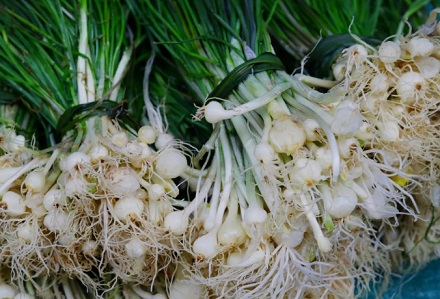Herbs And Phytochemicals: Saponins From Chinese Garlic Attenuates Endothelial Inflammation And Acute Lung Injury Via NF-κB/VCAM-1 Pathway
Nikhil Prasad Fact checked by:Thailand Medical News Team Mar 12, 2024 1 year, 1 month, 1 week, 6 days, 17 hours, 21 minutes ago
Herbs And Phytochemicals: Endothelial inflammation serves as a cornerstone in the pathogenesis and progression of a myriad of diseases, spanning from acute respiratory infections like COVID-19 to cardiovascular ailments, sepsis, metabolic disorders, cancers, and neuropsychiatric conditions. This intricate cascade of inflammatory responses encompasses heightened expression of adhesion molecules and the release of pro-inflammatory cytokines. In addressing the pressing need for safer and more effective anti-inflammatory therapies, this
Herbs And Phytochemicals news report delves into a study conducted by researchers from Jiangxi University of Chinese Medicine-China and Temple University, Philadelphia-USA on the therapeutic potential of saponins extracted from Allium macrostemon bulbs (SAMB) in attenuating endothelial inflammation and mitigating acute lung injury (ALI) through modulation of the NF-κB/VCAM-1 pathway.
 Bulbs Of Chinese Garlic (Allium Macrostemon)
The Crucial Role of Endothelial Cells
Bulbs Of Chinese Garlic (Allium Macrostemon)
The Crucial Role of Endothelial Cells
Endothelial cells (ECs), lining the inner walls of blood vessels, orchestrate pivotal functions in maintaining vascular homeostasis, regulating vascular tone, and modulating leukocyte activation. When ECs fail to perform their basal functions adequately, it leads to endothelial dysfunction, a hallmark of various diseases, including acute respiratory infections, cardiovascular diseases, sepsis, metabolic disorders, cancers, and neuropsychiatric disorders. The intricate interplay between inflammation and EC dysfunction underscores the urgent need for innovative anti-inflammatory therapies targeting endothelial inflammation markers such as ICAM-1.
The Pulmonary Endothelium in Acute Lung Injury
The pulmonary endothelium stands as a primary target in the pathogenesis of acute lung injury (ALI), serving as a gateway for circulating cells and humoral mediators. The dynamic interaction between leukocytes and ECs plays a pivotal role in ALI progression, marked by enhanced expression of endothelial cell adhesion molecules. While immune activation is essential for combating pathogens, an exaggerated immune response can culminate in a cytokine storm, precipitating tissue damage and organ failure. This study endeavors to explore the therapeutic promise of saponins from Allium macrostemon bulbs in safeguarding pulmonary endothelial integrity and alleviating ALI.
Allium macrostemon Bulbs - An Ancient Remedy Reimagined:
Allii macrostemonis (also known a Chinese Garlic) bulbs (AMBs), deeply ingrained in traditional Chinese medicine, have garnered reverence for their medicinal and dietary attributes since antiquity. Previous studies have unveiled a plethora of activities associated with AMBs, including anti-platelet aggregation, lipid-lowering, anti-tumor, antibacterial, and antidepressant effects, alongside antioxidant potential and analgesic properties. While the antioxidant prowess and regulation of nitric oxide production have been explored, a lacuna persists in understanding AMBs' modulation of endothelial function. This study aims to unravel the intricate mechanisms through which sapon
ins from Allium macrostemon bulbs safeguard endothelial integrity and mitigate inflammation.
Exploring the Anti-inflammatory Potential of Saponins from Chinese Garlic
Employing state-of-the-art methodologies, the researchers sought to dissect the anti-inflammatory efficacy of saponins from Allium macrostemon bulbs (SAMB) both in vitro and in vivo. In vitro experiments harness the power of human umbilical vein endothelial cells (HUVECs) stimulated with lipopolysaccharide (LPS) or tumor necrosis factor-α (TNF-α) to model endothelial inflammation.
Notably, SAMB demonstrates a remarkable ability to inhibit LPS-induced inflammation in HUVECs, evidenced by a significant reduction in pro-inflammatory cytokines and vascular cell adhesion molecule-1 (VCAM-1) expression. Mechanistic insights unveil the pivotal role of the NF-κB pathway, with SAMB mitigating NF-κB p65 phosphorylation and inhibiting VCAM-1 expression by stabilizing IκBα. Subsequent in vivo investigations in a murine model of septic ALI underscore SAMB's therapeutic potential, with SAMB attenuating lung injury and systemic inflammation.
Elucidating the Mechanistic Underpinnings
Mechanistic elucidation reveals SAMB's multifaceted mode of action in suppressing endothelial inflammation and mitigating ALI.
By stabilizing IκBα and inhibiting NF-κB p65 phosphorylation, SAMB exerts profound anti-inflammatory effects, dampening the expression of pro-inflammatory cytokines and adhesion molecules. Furthermore, SAMB showcases a remarkable ability to mitigate pulmonary tissue damage and suppress the inflammatory response in ALI, underscoring its therapeutic promise in combating endothelial inflammation-associated disorders.
Future Directions and Considerations
While this study provides compelling evidence of SAMB's anti-inflammatory efficacy, several crucial questions warrant further exploration. Firstly, elucidating SAMB's oral bioavailability and identifying its specific active ingredients are imperative. Additionally, unraveling the precise mechanisms underlying SAMB's IκBα stabilization function merits thorough investigation. Furthermore, optimizing SAMB dosage regimens to achieve maximal therapeutic efficacy while minimizing potential adverse effects remains paramount.
Conclusion
Saponins from Allium macrostemon bulbs emerge as a promising therapeutic avenue in mitigating endothelial inflammation and acute lung injury through modulation of the NF-κB/VCAM-1 pathway. This study unveils SAMB's multifaceted anti-inflammatory effects, underscoring its potential as a novel therapeutic agent for a spectrum of endothelial inflammation-associated disorders. Moving forward, rigorous clinical evaluation is warranted to harness SAMB's therapeutic potential fully and pave the way for transformative treatments in vascular and respiratory medicine.
The study findings were published in the peer reviewed journal: Molecules.
https://www.mdpi.com/1420-3049/29/6/1239
For the latest on
Herbs And Phytochemicals, keep on logging to Thailand Medical News.
